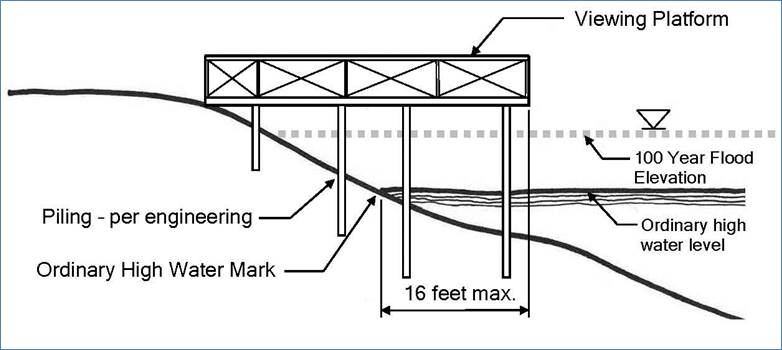13.11.120 Recreational development.
A. Recreational uses and facilities located within shoreline jurisdiction shall include features that relate to access, enjoyment and use of the water and shorelines of the state.
B. Sites with fragile and unique shoreline conditions such as high rank order wetlands and wildlife habitats shall be used only for nonintensive recreation activities, such as trails, viewpoints, interpretive signage and similar passive and low-impact facilities.
C. Accessory uses and support facilities such as maintenance facilities, utilities, and other non-water-oriented uses shall be consolidated and located in upland areas outside shoreline, wetland and riparian buffers unless such facilities, utilities, and uses are allowed in shoreline buffers based on the regulations of this SMP.
D. Structures associated with recreational development shall not exceed 35 feet in height. Exceptions for mechanical equipment and alternative architectural design may be allowed by the shoreline administrator in accordance with BMC 13.07.090, Table 13.07.090-1, footnote A.1.
E. Recreational development shall minimize effective impervious surfaces in shoreline jurisdiction and incorporate low impact development techniques consistent with the Bothell Surface Water Design Manual. The following standards shall apply:
1. Natural environment: 10 percent maximum effective impervious surface;
2. Urban conservancy: 10 percent maximum effective impervious surface – sites greater than 25 acres; 20 percent maximum effective impervious surface – sites less than 25 acres;
3. Shoreline residential: 50 percent maximum effective impervious surface; and
4. Marina and high intensity: Consistent with underlying zoning requirements.
F. Golf courses, playfields and other turf grass areas that require the use of fertilizers, pesticides, or other chemicals shall demonstrate best management practices and methods to prevent these chemical applications and resultant leachate from entering adjacent water bodies.
G. Recreational facilities shall provide vegetated physical separations from adjacent nonrecreational properties at least 20 feet wide consisting of landscaped strips, fences, signs, and other impediments to minimize potential impacts to private property.
H. Fishing or viewing platforms are only permitted on the Sammamish River and shall comply with the following minimum design standards (see Figure 13.11.120-1 for illustration):
1. The size of the structure should be the minimum necessary to safely accommodate the intended uses and number of users, and shall be no larger than 20 feet in width along the shoreline and eight feet deep over water.
2. The structure should not interfere with navigation nor block, obstruct or make dangerous any existing or planned public shoreline access.
3. The structure may be either a dock (ramp to float) design, or may be elevated on fixed piles. Either design must incorporate the maximum amount of functional grating that is feasible into the deck of the float or platform. If the structure utilizes piles, they must be the fewest number and smallest diameter feasible as determined by engineering requirements. If the structure utilizes a float, the landward edge of the float may be no farther than 10 feet waterward of the OHWM.
4. The structure shall comply with the same materials requirements for piles, decking or floats as found in BMC 13.11.030, Boating facilities.
5. Application materials for new or expanded over-water recreation structures shall provide habitat surveys, critical area studies, and mitigation plans as required by BMC 13.09.020, Environmental protection, and Chapter 13.13 BMC, Critical Areas Regulations in Shoreline Jurisdiction, as applicable. The mitigation plan shall discuss how the proposed project avoids and minimizes adverse impacts consistent with the facility’s sizing needs. A slope bathymetry map may be required when deemed beneficial by the shoreline administrator for the review of the project proposal.
I. Fishing or viewing platforms shall not provide boat moorage. See BMC 13.11.030, Boating facilities, or BMC 13.11.110, Private residential docks.
J. Recreational development shall meet environmental protection standards of BMC 13.09.020.
Fig. 13.11.120-1. Illustration of Fishing or Viewing Platform

(Ord. 2112 § 3 (Exh. C), 2013).